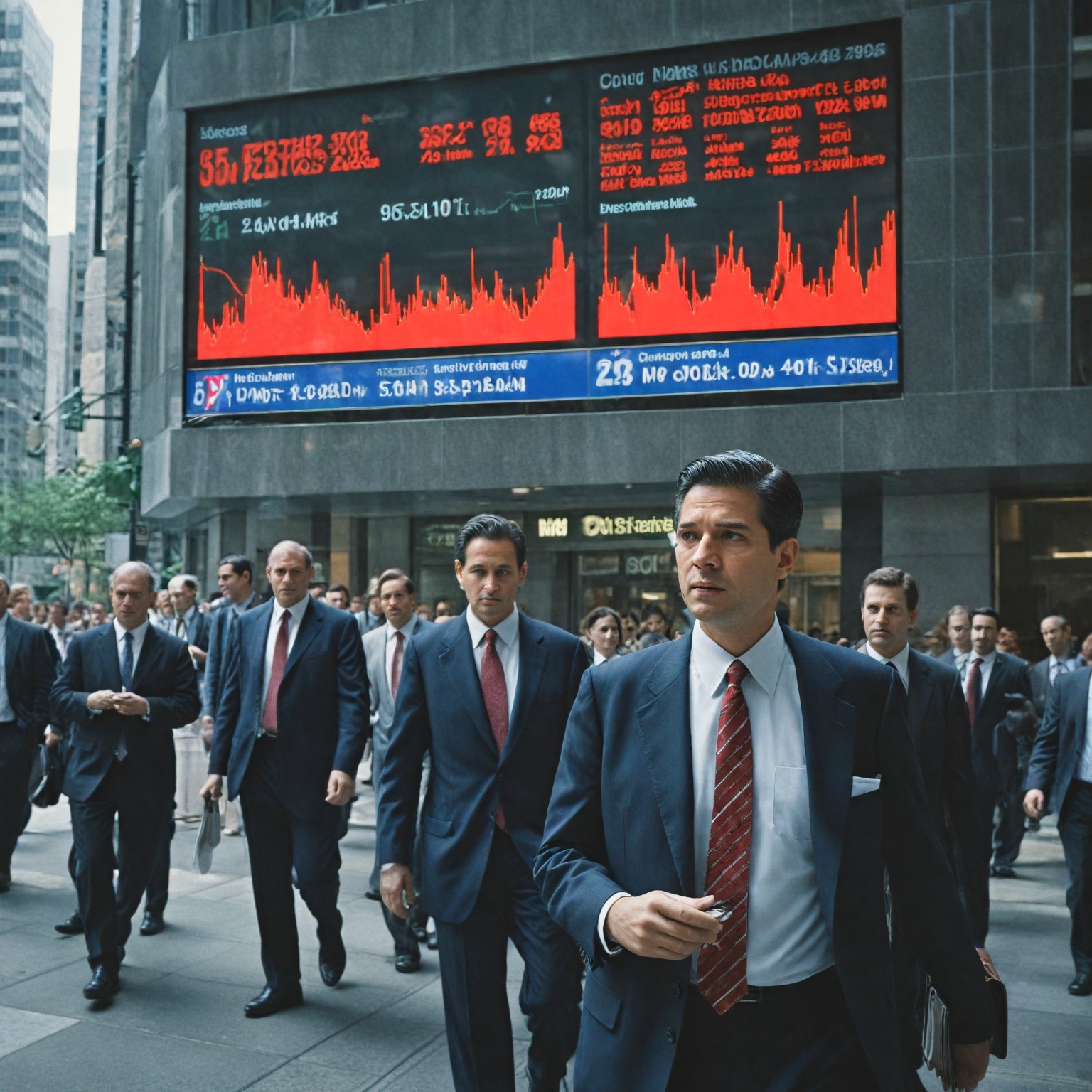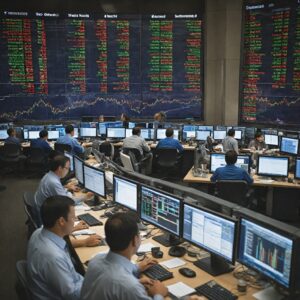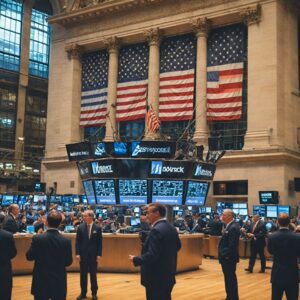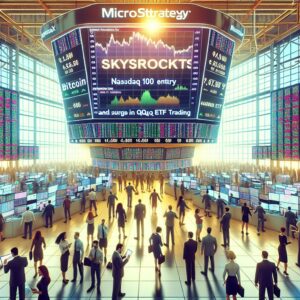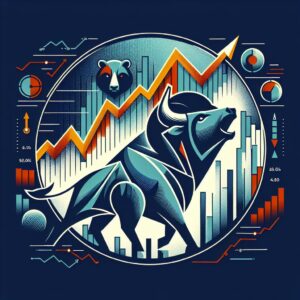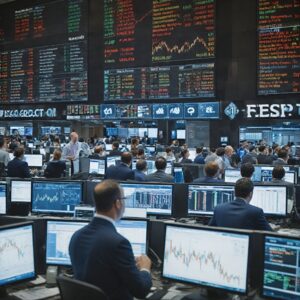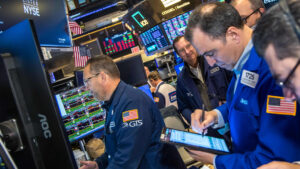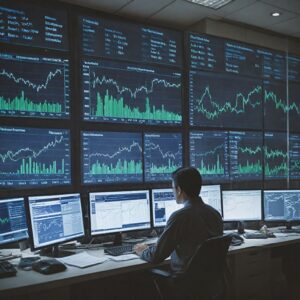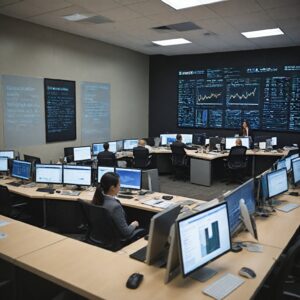Summary
Understanding the difference between an economic slowdown and a recession, and their respective impacts, is integral to assessing the health of an economy. A recession represents a significant, widespread downturn in economic activity, usually marked by two consecutive quarters of negative Gross Domestic Product (GDP) growth, and has lasting negative effects on key economic indicators such as employment rates, industrial production, and business investment. Conversely, an economic slowdown is a period of slower economic growth, and its effects, though still negative, are typically less severe and more localized. These economic phenomena can greatly affect investor sentiment and the stock market, with share prices often falling in advance of recessions and market downturns leading investors to move their money to safer investments. Economic policies and global trade changes can also contribute to economic disruptions, with bodies like the National Bureau of Economic Research (NBER) using a variety of measures to identify and track recessions. Both an economic slowdown and a recession have significant implications for monetary and fiscal policies, as well as consumer behavior and business operations.
Understanding Economic Slowdown and Recession
An economic slowdown and a recession are two different phenomena that occur in the economic cycle, and they have significant impacts on the overall economy. A recession refers to a period of significant, widespread downturn in economic activity, typically indicated by two consecutive quarters of negative Gross Domestic Product (GDP) growth. It is characterized by a sustained contraction in key economic indicators such as GDP, employment rates, industrial production, and business investment, leading to a decline in overall economic output.
On the other hand, an economic slowdown refers to a situation where there is economic growth, but at a reduced or slow rate. It can be seen in instances where the GDP growth rate decreases from one quarter to the next, despite the economy still growing. The effects of a slowdown may not be as severe as a recession, but it still leads to low production levels and an increase in unemployment levels.
Investors and the market are often sensitive to these economic changes. For example, share prices can be a leading indicator of company and economic health. The stock market is known to fall in advance of recessions but is also generally volatile. Market factors indicating a downturn can create a risk-off environment where investors move their money to safer investments.
Furthermore, the interconnectedness of global supply chains means that changes in trade policies, particularly tariffs, can have far-reaching consequences beyond the countries directly involved. These changes can impact trade flows, investor sentiment, and global equity markets, causing further economic disruptions.
Identifying a recession is a complex process. The National Bureau of Economic Research (NBER), the accepted arbiter of a recession, uses a variety of measures such as nonfarm payrolls, industrial production, retail sales, and GDP to determine the timing and length of a recession. They define a recession as a significant decline in economic activity that is spread across the economy and lasts more than a few months. The NBER Business Cycle Dating Committee tracks several economic indicators to identify U.S. recessions, which often continue to show growth around the time of a recession.
Monetary and fiscal policies often come into play during these periods, which involve actions taken by a central bank or government to achieve economic goals like low unemployment and stable prices. Furthermore, these economic conditions can also bring about new consumption patterns as consumers adapt to the changing economic environment, impacting businesses and the broader economy.
While both an economic slowdown and a recession pose challenges, their causes, degree, and manner in which they affect the economy differ significantly. Therefore, distinguishing between the two and understanding their impacts can provide valuable insights into the health and trajectory of the economy.
Monitoring Key Indicators
Monitoring potential signs of a recession is crucial in understanding the direction of the economy and making informed decisions . This involves examining a series of key economic indicators that can hint at a forthcoming recession . These indicators, which consist of multiple independent components, are created to reveal common turning points in the economy more convincingly than any single element . However, relying solely on one indicator can give misleading evidence about the state of the economy, especially during a pervasive economic downturn .
Leading and Lagging Indicators
Economists use a combination of leading and lagging indicators to anticipate and react to potential economic changes . Leading indicators include the shape of the Treasury yield curve, measures of confidence among consumers and businesses, and the stock market . These forward-looking metrics allow investors and policymakers to predict potential shifts in the economy and strategize accordingly .
On the other hand, lagging indicators such as unemployment rates and corporate profits confirm long-term trends but are slower to reflect changes. They offer a retrospective view of the recent economic past .
Sentiment and Stock Market Trends
Investor sentiment plays a vital role in market trends, often impacting the mean-variance tradeoff on the market portfolio . Sentiment-induced buying and selling significantly influence stock price variations . A positive sentiment can create a risk-on environment where investors perceive less risk about the market and its outlook, whereas a negative sentiment can lead to a risk-off environment indicating a market downturn and increased risk .
Several factors can influence investor sentiment, including macroeconomic indicators, political events, economic uncertainty, and financial market trends . For instance, in periods of political uncertainty, information-sensitive institutions such as hedge funds adjust their holdings based on their perception of risk and the short- or long-term prospects of firms .
Consumer Spending and Corporate Profits
Consumer spending is a significant driver of the economy, representing a substantial percentage of the nation’s Gross Domestic Product (GDP) . Changes in consumer values and spending behavior critically impact the growth of national economies and companies . Meanwhile, corporate profits, which serve as lagging indicators, confirm long-term economic trends .
Institutional investors also react to uncertainty by reducing their holdings in stocks considered unsafe and reallocating funds to other asset classes like precious metals, government bonds, and money-market instruments .
Predicting Fund Performance
Forward-looking systems such as the Morningstar Medalist Rating aim to predict funds’ performance against a relevant benchmark index or peer group . This system uses a scale ranging from Gold to Negative, with higher ratings denoting a conviction in a fund’s ability to outperform . Such a system unifies analyst insights with scalable machine learning models to understand how a company’s sustainable competitive advantages impact its long-term economic profits . The Morningstar Medalist Rating simplifies and harmonizes ratings, keeping analyst views central while fully leveraging the scale benefits of the Morningstar Quantitative Rating .
Effects of Economic Slowdown and Recession
Recession
During a recession, there is a sharp decline in production levels and a significant rise in unemployment rates. Businesses often cut down their production to minimize exposure to risk, leading to a ripple effect throughout the economy. As fewer goods are produced, there is a reduced demand for resources like raw materials and labor. This decline in output negatively affects sales and profit margins, ultimately leading to a decrease in hiring and an increase in layoffs. This scenario can be gauged by analyzing economic indicators such as construction spending, which measures the amount of monthly expenditure towards new construction.
Economic Slowdown
During such a phase, consumers tend to prioritize experiences and digital products over physical goods. This shift in consumption patterns forces businesses to adapt to the changing market trends. It also affects the growth of GDP and company revenues, as consumer spending plays a critical role in driving both. However, an economic slowdown does not necessarily result in negative GDP growth.
Governmental Influence
The role of the government is pivotal in determining the economic conditions of a country. Through policy, regulation, and legislation, the government can influence taxes, trade, markets, and interest rates. There is a strong belief that a focus on the economy or jobs would enhance democracy. Other popular suggestions for improvement include better infrastructure, healthcare, and housing policies. Both the Congressional Budget Office and the Joint Committee on Taxation use various models that consider assumptions about people’s foresight, the connection of the United States to the global economy, the impact of government borrowing on private investment, and the response of businesses and individuals to tax changes.
Public Sentiment
Public sentiment towards economic conditions can also vary significantly. As shown in a ConsumerWise survey, despite stable inflation, low unemployment, and ongoing job growth, not all U.S. consumers felt optimistic about the economy. Around 46% of consumers felt positive in the first quarter of the year, while just over a third reported mixed feelings, and pessimism slightly increased from the previous quarter.
Government Policies and Market Dynamics
Impact on Trade and Economy
Government policies can also significantly impact trade, particularly through uncertainty in the financial market and trade policy. It has been observed that uncertainties in the financial market can negatively impact imports in advanced economies over a long period. However, uncertainties in domestic economic and trade policies may positively affect imports in the short run. For instance, the introduction of tariffs, such as those imposed by the Trump administration on Canada and Mexico, significantly impacted all three economies. To alleviate the adverse effects of uncertainties in the economic, trade, and financial market on the performance of imports in advanced economies, it is crucial to develop appropriate policy implications.
Influence on Investor Sentiment
Beyond macro-level effects, government policies and economic indicators can have substantial effects on investor sentiment. Macroeconomic indicators, political events, economic uncertainties, and financial market trends all have the potential to influence investor sentiment. Fluctuations in interest rates, for instance, have a notable impact on investor sentiment. This sentiment, according to behavioral finance theories, can influence financial asset prices and the decision-making processes within financial markets. An understanding of investor sentiment’s impact on price formation, especially in various U.S. stock market indices, provides a more comprehensive understanding of the financial markets’ functioning.
Strategies to Counter Economic Slowdown and Recession
Investment Strategies
Investors, both large institutional and average individuals, play a crucial role in the economy. During an economic slowdown or recession, it’s crucial to avoid behavioral bias in investment decisions, such as selling low during market declines or buying high during market upturns, as these may lead to less than ideal long-term investment outcomes. Instead, investors should strive to stay diversified across different types of investments, such as equities, core bonds, credit, and alternatives, which can potentially mitigate portfolio volatility.
Moreover, it’s essential for investors to keep their investment portfolio aligned with their long-term financial goals through regular rebalancing.
Governmental Strategies
Governments have a substantial impact on the economy and can counter economic slowdowns and recessions through policies, regulation, and legislation. These can affect various economic aspects, including taxes, trade, markets, and interest rates. The approach to handle the slowdown or recession can vary between countries and depends on the specific circumstances of the economy.
Market Behavior During Slowdown and Recession
During periods of economic downturn, whether it’s a slowdown or a recession, the behavior of the market changes significantly. This shift is primarily due to a decrease in demand for goods and services, which often arises from policies used excessively, leading to an eventual recession. It is also influenced by financial market problems, such as sharp increases in asset prices and rapid credit expansion that often coincide with rapid debt accumulation.
Investor Behavior
Investor sentiment during such economic downturns is influenced by a myriad of factors including macroeconomic indicators, political events, economic uncertainty, and financial market trends. In times of uncertainty, such as the threat of war or recession, institutional investors often reduce their holdings in stocks considered unsafe and move the funds to other asset classes like precious metals, government bonds, and money-market instruments. The average investor is often advised to be as well-informed as possible and to create a strategic investment plan during stable market conditions.
Impact on Consumer Spending
Changes in the economic landscape greatly impact consumer spending behavior. As evident from a ConsumerWise survey, stable inflation, low unemployment, and ongoing job growth led to economic optimism among US consumers in the first quarter of the year. However, changes in consumer values and spending behavior can significantly affect companies’ revenues and margins and the overall growth of GDP.
Government Influence
Government policies, regulations, and legislation can have a massive impact on the economy and, by extension, the market. Thus, the desire for governments to focus more on domestic issues than international or multilateral ones is often expressed. As such, several countries express a need for better infrastructure, healthcare, or housing policies to improve the economy and, consequently, democracy.
Economic Uncertainty and Its Effects
Economic uncertainty, especially those driven by threats of war, recession, or changes in economic policy, can significantly impact the behavior of investors and trade . For instance, large institutional investors and currency futures traders are likely to move their currency away from unstable sources to stable ones . Additionally, companies within an economy, particularly those producing consumer goods, may also face significant consequences of economic uncertainty. As consumers become more wary of spending due to potential threats of recession, companies may be forced to cut down their workforce to compensate for lower sales, thereby increasing unemployment and further reducing consumption .
A key aspect of economic uncertainty lies in its influence on investment decisions . The theory suggests that a surge in uncertainty can deter firms and individuals from investing, thereby reducing growth . However, it’s also important to note that high volatility, often associated with high uncertainty, can also create high opportunities . Therefore, the effect of economic uncertainty on investments may not be as straightforward as it initially seems.
The effects of economic uncertainty extend beyond national boundaries, given the interconnectedness of global supply chains. For instance, shifts in trade policies, especially tariffs, can lead to far-reaching consequences, disrupting trade flows, investor sentiment, and global equity markets .
There’s also a significant interplay between economic uncertainty and stock market volatility. Time-varying risk aversion and macroeconomic, financial, and economic policy uncertainty measures can strongly influence stock market volatility and correlation . Risk aversion, along with fundamental factors, reflects investor sentiment, playing a crucial role in predicting stock market volatility .
Case Studies
Impact of Uncertainty and Interest Rates on Investor Sentiments
Investor sentiments, economic policy uncertainty, U.S. interest rates, and financial assets are interconnected. A study conducted from March 21, 2017, to March 20, 2023, demonstrated this interdependence using a quantile VAR-based connectivity technique and wavelet multiple local correlations. Behavioral finance highlights the influence of investor sentiment on financial asset prices and how macroeconomic indicators, political events, economic uncertainty, and financial market trends can affect this sentiment. Notably, fluctuations in interest rates can sway investor sentiment significantly.
Recessions and Financial Market Problems
Historically, recessions often find their roots in financial market difficulties. Examples include the recession that began in 2007, driven by sharp increases in asset prices, rapid credit expansion, and rapid debt accumulation. As corporations and households struggle to meet
The content is provided by Harper Eastwood, Financial Pulse Now

